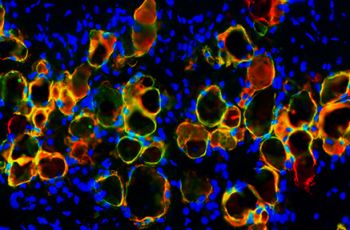Some people tell Congresswoman Debbie Wasserman Schultz (D-FL) that she is lucky to be alive. But Wasserman Schultz, who battled a particularly lethal type of breast cancer, attributes her survival to more than luck. “While I was certainly fortunate to have access to good health care, I didn’t find my tumor early because of luck," she said at the “Eliminating Breast Cancer Health Disparities: Communicating to At-Risk Populations” symposium, March 10. "I found my tumor early because of awareness and education.”
As the event's keynote speaker, Wasserman Schultz used her personal experience to underscore the importance of both knowledge and access to care in the fight against breast cancer. Hosted by The George Washington University School of Medicine & Health Sciences (GWSMHS), the The George Washington University Medical Faculty Associates (MFA), the Avon Foundation for Women, and Friends of Cancer Research, the symposium explored how cancer centers, community health centers, advocacy organizations, and government agencies can improve communication with underserved populations in order to eliminate breast cancer disparities.
Although breast cancer does not discriminate-- it affects one in eight American women--the disease is more prevalent in certain populations. For instance, white women are more likely to be diagnosed with breast cancer, but black women are more likely to die from it. Additionally, an aggressive and difficult to treat type of cancer called "triple negative" is more prevalent in African American, Hispanic, and pre-menopausal women. Because such disparities are attributable to both biological differences and societal barriers to care, a multifaceted solution is needed to their mitigation, the day's speakers agreed.
“Across the University, we are conducting research on issues related to [breast cancer], including in the basic sciences, clinical medicine, and public health,” said GW President Steven Knapp in his opening remarks. “Much of our work is focused directly on our community here in Washington, D.C., where the mortality rates from breast, prostate, and colorectal cancer are among the highest in the nation.”
The symposium featured a panel of local and national breast cancer advocates led by Rachel Brem, M.D., director of the Breast Imaging and Intervention Center at GWSMHS. The panel--which included Christopher Masi, M.D., Ph.D., assistant professor of Medicine at the University of Chicago; Steven Taplin, M.D., M.P.H., from the Division of Cancer Control and Population Sciences at the National Cancer Institute; Tesha Coleman, program director of Clinical Services at the Capital Breast Care Center; and Marc Hurlbert, Ph.D., director of the Avon Foundation Breast Cancer Crusade--shared tactics for disparity elimination.
In the lab, continuing to study how genetic differences contribute to disparities is key to their ultimate elimination. "It's clear from NCI's perspective that our understanding of basic biology has implications for everybody," said Taplin. "The issue of disparities is something that benefits everybody."
The speakers underscored the importance of boosting minority participation in research studies in order to influence the must vulnerable populations. Unfortunately, noted Masi, a pervasive mistrust of the federal government and the medical community among minority communities can deter recruitment. "We need more minority physicians," he suggested. "These individuals will hold a lot more credibility in different groups in terms of encouraging them to be a part of clinical trials."
The Avon Foundation is also helping to increase enrollment numbers through its new program called "Army of Women," a database of healthy female volunteers. By connecting researchers with a variety potential subjects, the program strives to accelerate cancer research, said Hulbert. "The key is to really educate the public and engage them in the clinical research process."
Of course, cancer disparities are not only biological, the panelists emphasized. Access to care --both physical and financial-- greatly affects individuals' likelihood of receiving timely and effective screening, diagnosis, and treatment. According to Coleman, one effective method for improving access among underserved populations is the use of patient navigators, or trained guides who assist people through the cancer care continuum.
Insurance status was also recognized as a key factor determining whether or not women seek screening and receive appropriate care. Fortunately, the implementation Patient Protection and Affordable Care Act will help address this issue, said Wasserman Schultz. "Health care reform is a giant leap forward in eliminating health care disparities," she said.
Finally, the symposium examined the impact of the fall 2009 United States Preventive Services Task Force recommendation against both routine mammograms for women under age 50 and breast self-examination. Because the decision countered previous recommendations and those of other health organizations, the speakers agreed that information dissemination is more important than ever before.
"If there is one message here, it's that there are multiple messages," concluded Brem. "We have to work collaboratively with research, with education, with community health services in order to really optimize the care for all women."


